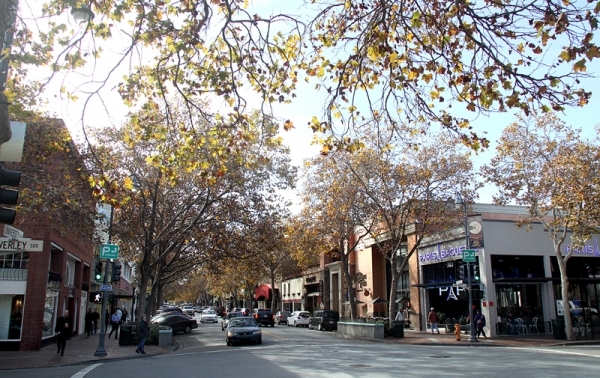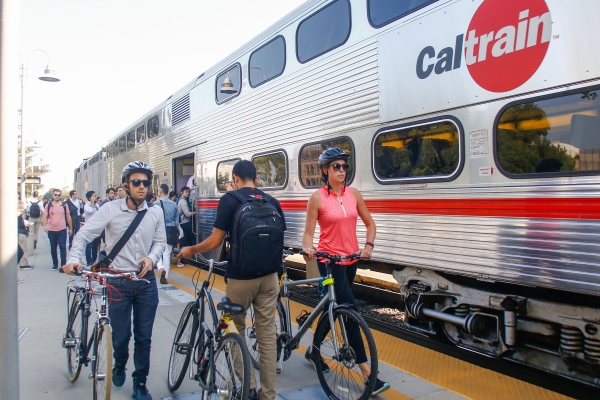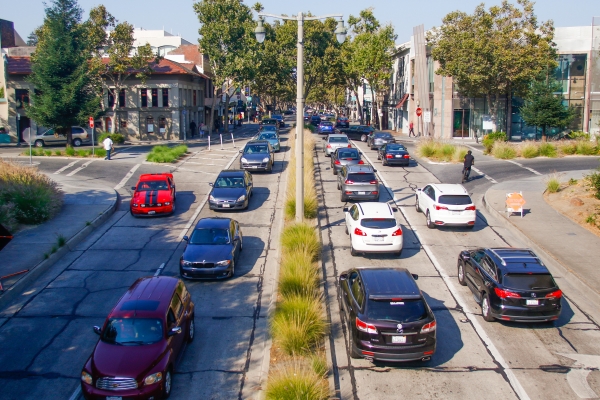They serve food, wash dishes, staff shops and hotels and play a leading role in keeping downtown Palo Alto buzzing for residents, employees and visitors.
But as the city rolls out its effort to fight traffic congestion, downtown's service employees also represent the biggest obstacle and toughest challenge. While many tech workers and City Hall employees have embraced Caltrain and ride-share options like Lyft and Scoop in recent years, the vast majority of the employees in the service sector reported last year that they drove alone to work, according to a survey commissioned by the Palo Alto Transportation Management Association, a nonprofit charged with getting people out of cars and into other modes of transit.
That, however, may be slowly changing. A more recent survey, conducted in May and June, shows the percentage of service workers reporting that they drove alone had dipped from 80 percent in 2016 to 70 percent.
For the association, an organization that the City Council created three years ago, the number is significant for several reasons. Service workers make up both the largest segment of downtown's workforce and the one that's hardest to reach. Many hold multiple jobs, work part-time or have irregular shifts that make it difficult, if not impossible, to take public transit.
Furthermore, service workers are far less likely than their counterparts in the government and technology sectors to receive transit benefits from their employers. According to the new survey, 66 percent of the tech workers and 49 percent of the government workers reported receiving transit subsidies. Among light-office and service workers, the rates were 17 percent and 8 percent, respectively.
The new survey provides some hope for both the association and for the council, which is preparing to invest more money and energy into combating traffic downtown through a strategy known as "transportation demand management." Earlier this summer, the council approved a budget that allocates $480,000 to support the effort, allowing the nonprofit to add new services and increase the number of transit subsidies it offers to commuters.
The scientifically valid survey, which was conducted by EMC Research, shows 53 percent of the respondents reporting they drove alone to work in the prior week, down from 56 percent in 2016 and from 57 percent in 2015. It also indicates that 20 percent relied on transit (up from 18 percent in each of the prior years) and that 8 percent relied on ride-share services, up from 6 percent in 2016 and from 5 percent in 2015.
The survey findings come at a time when traffic congestion and parking shortages remain top council priorities. Earlier this year, the council approved design contracts for new garages in downtown and near California Avenue; invested $9.6 million in new bike projects; and approved a new Residential Preferential Parking (RPP) program in the Southgate neighborhood, the third such program to win approval in the past three years.
The council also agreed in late June to raise the price of an annual parking permit for downtown garages from $466 to $730. On California Avenue, the cost of the permit was raised from $149 to $365. Proceeds from the permits would be allocated to the association for programs that discourage driving. The council also agreed to decrease the number of parking permits sold to downtown employees by 10 percent every year, to pressure them to take other modes of transportation.
Not everyone is thrilled about the shift. Shortly before the June 27 council vote, Councilman Greg Tanaka recalled a recent community meeting he held that attracted "cranky restaurateurs" who said the new fees would further hinder their ability to retain workers.
"What's happening is the parking fees are stacked against these community-serving retailers and restaurants," Tanaka said. "That's the anxiety I have over current parking increases."
But the new survey results suggest that these efforts, while painful for many workers, are also leading commuters to park their cars in garages rather than on neighborhood streets. In 2015, before downtown's RPP was established, 19 percent of downtown's drivers said they parked on neighborhood blocks, according to the survey. That rate has dipped to 9 percent in 2016 and to 7 percent this year, according to the survey.
While the council is swinging the stick -- in the form of higher permit fees -- at downtown's service workers, the association is offering them carrots. The nonprofit currently subsidizes transit passes for 100 employees who make $50,000 or less. It also offers subsidies to riders who use Scoop, a carpooling company that caps the cost of taking a ride at $2.
The menu is also continuously expanding. In recent months, the transportation association has begun working with the downtown business Palo Alto Bicycles to offer employees who live within 5 miles of their jobs bicycles that they can use for commute purposes (after six months, they have the option of buying the bikes for the nominal amount of $50). And at its last meeting, the association's board of directors approved an agreement with Waze, which is now rolling out its own carpooling service. The idea is to give employees who have a hard time getting a carpool match with Scoop another option, board members said at the July 13 meeting.
For the association, the survey results underscores the link between transit subsidies or pre-tax payroll deductions for transportation and workers giving up solo driving. Of the 32 percent of the survey respondents who received transit benefits, only 27 percent reported driving alone. Of the 54 percent who did not, the drive-alone rate was 70 percent.
In a statement that accompanied the survey results, the nonprofit pointed at the decreasing numbers of solo-driving service workers as evidence that its programs are working.
"These reductions are largely the result of programs launched in the past year which
subsidize the cost of monthly transit passes for low income workers working in service industries," the nonprofit stated.
The survey also suggests that there is a direct correlation between employees who have parking permits and drive-alone rates. Seventy-five percent of the survey respondents who had parking permits reported that they drove solo; among those who did not have permits, the rate was 65 percent.





Comments
Another Palo Alto neighborhood
on Aug 24, 2017 at 11:30 am
on Aug 24, 2017 at 11:30 am
Any idea on the number of restaurant jobs or cashier jobs empty due to the fact that they can't get employees?
Any discussion on off ramp parking with dedicated shuttles to get employees into town?
No, I didn't think so!
Embarcadero Oaks/Leland
on Aug 24, 2017 at 11:38 am
on Aug 24, 2017 at 11:38 am
" Earlier this summer, the council approved a budget that allocates $480,000 to support the effort, allowing the nonprofit to add new services and increase the number of transit subsidies it offers to commuters."
So glad the resident taxpayers can help fund the commuters, including city employees? What's the business community doing to pay us back?
University South
on Aug 24, 2017 at 11:45 am
on Aug 24, 2017 at 11:45 am
Online Name - that $480,000 is funded dollar-for-dollar by increased parking fees for workers (with low-income workers excepted). Since workers making less than twice minimum wage can get $100 passes, that means the fees are mostly being paid by tech companies that purchase garage passes for their workers.
Sounds pretty fair to me. And the tech companies aren't complaining either.
Registered user
Community Center
on Aug 24, 2017 at 12:20 pm
Registered user
on Aug 24, 2017 at 12:20 pm
@Council Watcher
Thanks for your clarification about the steep discounting of parking passes for lower income restaurant and retail workers, but how do you explain Tanaka's claim that the new parking pass rates are stacked against these workers?
Crescent Park
on Aug 24, 2017 at 12:53 pm
on Aug 24, 2017 at 12:53 pm
Council watcher-- are you sure that none of the 480,000 dollars comes from permits that residents are forced to purchase? We didn't have a problem until this parking program pushed parking from downtown on to the street where we live. Seems to me to be a tax on the residents to fund the program. I don't have a problem with subsidizing low income workers, but let's not kid ourselves that there are not costs to residents that did not exist before. Call it a tax or call it a permit , it is money out of our pocket.
another community
on Aug 26, 2017 at 12:07 pm
on Aug 26, 2017 at 12:07 pm
>>They serve food, wash dishes, staff shops and hotels and play a leading role in keeping downtown Palo Alto buzzing for residents, employees and visitors.
I commute from Tracy to work in a downtown PA hotel as a food server. To carpool is impractical.
Fortunately I can park in the hotel parking lot. For those who work downtown, parking can be a problem.
Why do city employees get free parking? What makes them so special?
Midtown
on Aug 26, 2017 at 5:48 pm
on Aug 26, 2017 at 5:48 pm
It's one of the perks. By accepting lower salaries (in comparison to private industry) for the lucrative retirement benefits of CALPERS, free parking is just another 'add-on'. Don't complain. Just take a civil service exam and pass the interviewing process. Guaranteed...your opinion will change.